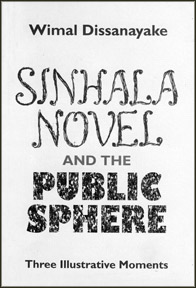
Insightful discourse
Sinhala Novel and the Public Sphere:
Prof. Wimal Dissanayake through three
illustrative moments in the Sinhala literary scene analyses how Sinhala
novel has influenced the Public Sphere in Sri Lanka. Outlining Jurgen
Habermas's capacious concept of Public Sphere, he ventures to describe
the Public Sphere in Sri Lanka and how it has been influenced and shaped
up by Sinhala novel. Through three illustrative moments; Piyadasa
Sirisena and the Discourse of Cultural Nationalism, Martin
Wickremasinghe and the Anxieties of Modernism and Gunadasa Amerasekara
and Representation of History, Prof. Dissanayake encapsulates the
influence that Sinhala novel exerted on Public Sphere from the
pre-independent era to the contemporary Sri Lanka
Reviewed by Ranga Chandrarathne
 In the introduction to the book, Prof. Wimal Dissanayake outlines his
three subjects namely the novels of Piyadasa Sirisena, three novels of
Martin Wickremasinghe and seven novels of Gunadasa Amerasekara. In the introduction to the book, Prof. Wimal Dissanayake outlines his
three subjects namely the novels of Piyadasa Sirisena, three novels of
Martin Wickremasinghe and seven novels of Gunadasa Amerasekara.
At the outset, the author points out that though novels of Piyadasa
Sirisena lack complex human experiences, well-evolved characters and
more similar to didactic early prose in Sinhala, Piyadasa Sirisena has
considered the novel as a tool of generating public opinion and stirring
passion in order to propagate cultural nationalism.
Whilst Piyadasa Sirisena's novels mark an important phase in the
transition of didactic prose into the novel, Martin Wickremasinghe's
novels, on the one hand, mark the evolution of modern Sinhala fiction
and on the other hand display a central role that fiction can play in
the public sphere.
Comparing the novels of Martin Wickremasinghe with those of Piyadasa
Sirisena, Prof. Wimal Dissanayake states:
"In terms of the complexity of experience, the depth of
characterization, narrative techniques and the fashioning of ductile
language medium appropriate for the configuration of modern Sri Lankan
experiences, these novels represent a decisive advance over the work of
Piyadasa Sirisena, "
He identifies the seven novels of Gunadasa Amerasekara commencing
with Gamanaka Mula (1984), as the third illustrative moment. The seven
novels, the author states, indicate further evolution of Sinhala novel
and the complex manner in which contemporary social and political
history can be woven into fictional representation.
Capacious concept of public sphere
The author discusses in detail the interaction of Sinhala novel with
public sphere and how it had influenced in the formation of perceptions
citing three illustrative moments; in fact, thereby, revisiting three
important phases in the evolution of Sinhala novel. Since the analysis
is grounded on the spacious concept of public sphere, it is imperative
here, at least in brief, to discuss the concept of Public Sphere. The
author states that according to German philosopher Jurgen Habermas
Public Sphere is "a domain of our social life where such things as
public opinion can be formed (where) citizens.. deal with matters of
general interest without being subject to coercion.. to express
publicize their views".
Cultural nationalism
In conclusion of the chapter on Public Sphere, the author states that
the concepts of public sphere and civil society as they enter into non
-Western discourses are inflected by local realities as well as
place-based traditions of thinking.
The author emphasised the fact that Sri Lankan public sphere was, to
a greater extent, strengthened by journalists, playwrights, novelists
and poets.
He particularly cites the contribution made to this end by Munidasa
Kumaratunga, John de Silva, Ven. S. Mahinda, Anagarika Dharmapala,
Piyadasa Sirisena, Martin Wickremasinghe and Gunadasa Amerasekara.
In extensively dealing with the work of Piyadasa Sirisena, it has
been stated, among other things, that Piyadasa Sirisena was a novelist,
poet, influential newspaper editor and also an activist who played a
vital role in anti-colonial struggle. He worked along with influential
public figures such as Anagarika Dharmapala, Ven. Mohottiwatte Gunananda,
Ven. Hikkaduve Sumangala and Walisinghe Harischandra. Piyadasa Sirisena
is also considered as the 'father of Sinhala fiction'.
However, it has also been mentioned that there are five principal
players in the making of Sinhala fiction; Rev. Isaac de Silva
(1844-1907), Bentota Albert de Silva (1866-1919), A. Simon de Silva
(1874-1920), M.C.F Perera (1879-1946) and Piyadasa Sirisena (1875-1946).
The author describes Piyadasa Sirisena as a novelist of advocacy and
a propagator of cultural nationalism. The dominant themes of his work
range from religion, upholding indigenous values and heroes who triumph
at the end of the day against enormous odds over the evil. It is always
the good triumph over evil.
"In his novels Piyadasa Sirisena portrayed a broad range of
characters of Kandyan nobility, low country elites, lawyers, doctors,
teachers, businessman, police officers, Buddhist monks, prostitutes,
drunkards, and social hypocrites. However, they belonged to readily
identifiable broad categories-positive and negative characters.
The positive characters upheld traditional virtues and pieties and
prospered while those who chose to traverse the opposite path ended up
in defeat and failure. In terms of complexity of characterization,
Piyadasa Sirisena's work suffer by comparison with later writers such as
Martin Wickremasinghe "states the author. Prof. Dissanayake stressed the
fact that in any discussion of the interconnectivities between Sinhala
fiction and public sphere in Sri Lanka, Piyadasa Sirisena occupies a
central position for a number of reasons including those of his being a
novelist, poet, journalist and activist in the anti-colonial struggle.
In the chapter 'Martin Wickramasinghe and the Anxieties of Modernity',
the author offers a sharp analysis on the three novels of Martin
Wickremasinghe; Gamperaliya (1944), Kaliyugaya (1957) and the Yuganthaya
(1949).
The central theme of the trilogy is the rise and growth of middle
class against the collapse of feudalism. "Gamperaliya charts with great
subtlety the experience of social change. Change comes to the peasant
community, but much of it is endogenously generated" states the author.
It is noteworthy to acknowledge the fact that Martin Wickremasinghe had
captured this social transformation with remarkable cultural
sensitivity.
It has been mentioned that in Kaliyugaya , 'the experiences of the
city is central to the meaning of the novel. Prof. Dissanayake states,
"The novel establishes the point that the city is decidedly a product of
culture, but that it is also a producer of culture.
Being a generator of modernization, cities influence and shape the
evolving patterns of cultures even as they contain essential currents of
those cultures."
The chapter concludes with a note that among other things, Martin
Wickremasinghe's novels create a knowable community as described by
Raymond Williams.
In conclusion, the author points out that Gunadasa Amerasekara can be
marked for interpreting history and his seven novels go beyond the
classical definition of realistic fiction on many counts.
The book is a must read for Sri Lankans in general and scholars in
particular. The book sheds light on myriad aspects of Sinhala novel and
its conjunctions with public sphere in Sri Lanka.
|

